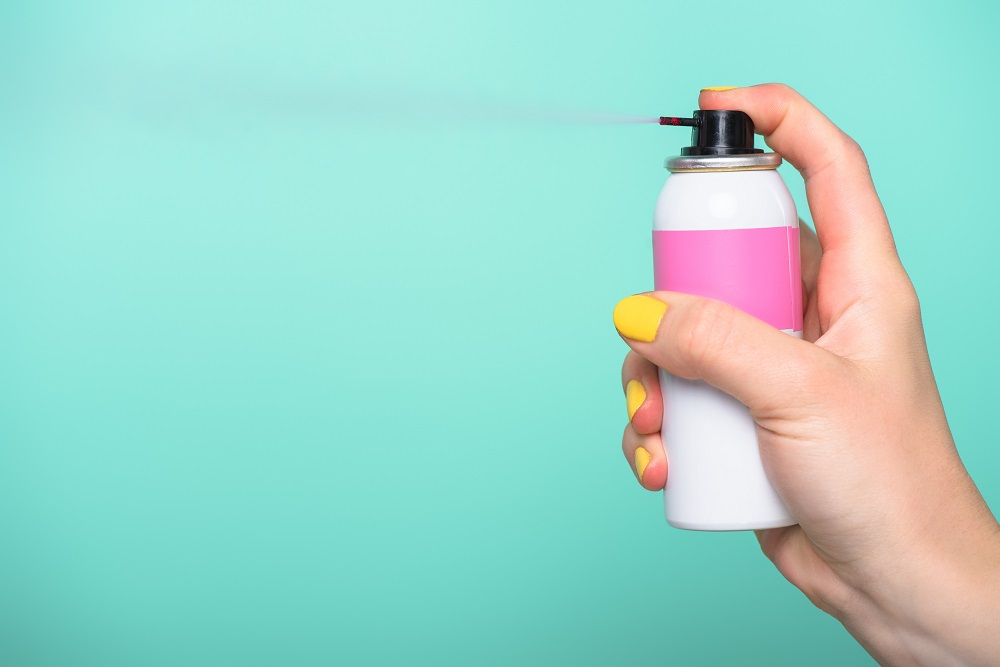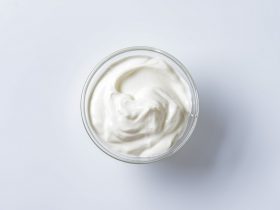Hair changes during pregnancy may lead women to look for new products that are safe and effective. Hair sprays are commonly being used before and during pregnancy. But there are studies linking the use of hair sprays to some adverse pregnancy outcomes.
Exposure to phthalates and other endocrine disrupting chemicals has been found to cause adverse effects to pregnant women and their children. However, chemical absorption from hair spray use is considered very minimal and are not known to cause harm. Nevertheless, the safest option for women is to use as little hair chemicals as they can to eliminate any risk to their unborn baby.
Jesmarie Macapagal, RN, MD, DPPS
This article will describe what hair spray is and what it is commonly used for. Then it will explain what harmful chemicals are potentially present in hair sprays. Effects of exposure among pregnant women according to research will also be discussed. Finally, some recommendations on the use of hair sprays during pregnancy will be presented.
What is Hair Spray?

Hair spray is one of the most popular hair care products used by women to keep their hair in position. Like wax or gel, hair spray is used to adjust the “lift” of the hair shaft (Madnani & Khan, 2013). It also provides weather resistance and hair shine (Puccetti & Thompson, 2017).
Hair sprays are marketed as a quick-drying liquid propelled from an aerosol can that is sprayed to either wet or dry hair to help hold a particular style in place. Hair sprays can be used as a finishing hold, for styling the hair, to form curls, to tame unruly strands, to hide fringes of oily hair, and to give an appearance of more hair volume.
Common ingredients used in hair sprays include alcohol and polymers, like those used in paint and glue. These compounds make the hair shafts stick together for a short period of time.
Harmful Chemicals in Hair Spray
There is increasing interest in the potential harm to health caused by endocrine disrupting chemicals (EDCs) (Diamanti-Kandarakis et al., 2009). EDCs are defined as “an exogenous chemical, or mixture of chemicals, that can interfere with any aspect of hormone action” (Yilmaz et al., 2020). These compounds can either mimic human hormones, inhibit the action of hormones, or change the normal regulation of the human endocrine system (Sikka & Wang, 2008).
Exposure to EDCs in utero can have potential adverse anti-androgenic effects on male sexual development, especially during early pregnancy, at which period the external genitalia develops (Skakkebaek et al., 2001). EDCs contained in commonly used personal care products include phthalates, bisphenol A (BPA), perfluorinated chemicals, triclosan, and parabens (Witorsch & Thomas, 2010).
Phthalates are widely used in personal care products (Schettler, 2006). Use of these everyday products has led to almost ubiquitous exposure to phthalates in industrialized countries. Phthalates may be directly ingested from food or applied directly as skin care products, or inhaled in the air containing phthalate particulates (Wormuth et al., 2006).
Toxicological research has shown that phthalates have the potential to affect the human hormonal systems and human sexual development and reproduction (Wormuth et al., 2006). Studies have suggested that phthalates disrupt the body’s hormones and affect the development of the reproductive system, leading to the development of hypospadias. Hypospadias is one of the most common congenital defects of the male genitalia, where “the urinary opening is displaced to the underside of the penis” (Imperial College London, 2008).
In Europe, prevalence rates of hypospadias are estimated to be anywhere from 4 to 24 per 10,000 live births (Dolk et al., 2004). Higher rates have been reported in the United States (Ormond et al., 2009). In 2010, Nassar et al. demonstrated that women with history of exposure to phthalates were more likely to have a male offspring with hypospadias.
Likewise, a study by Haraux et al. in 2017 suggested that maternal occupational exposure to EDCs may be considered a risk factor for hypospadias. It also linked the possible effects of household use of hair care products among women during their early pregnancy to the development of hypospadias in their children.
In the United States, regulations do not require product labels to list individual fragrance components. Hence, phthalates are almost never seen in their list of ingredients (Parlett et al., 2013). But research has shown that phthalates remain among many hair products.
In a survey by Hubinger & Avery (2006), at least one phthalate ester was found among most consumer cosmetic products, including those for hair care. Phthalates were also detected by Koniecki et al. (2011) in hair sprays and hair mousses. Shen et al. (2007), likewise, determined several kinds of phthalates and parabens among cosmetic products, including hair sprays.
In 2013, Parlett et al. investigated in a cohort of women the associations between use of personal care products and appearance within 24 hours of phthalate metabolites in the urine. Results showed a positive link to use of perfumes, hair sprays, nail polish and deodorants to higher concentrations of monoethyl phthalate, which is the primary metabolite of diethyl phthalate.
Adverse Effects of Exposure to Hair Spray During Pregnancy
Data on humans remain inadequate and inconclusive (Ormond et al., 2009). Very limited studies have been done to find out the effects of exposure to hair chemicals among pregnant women. Even so, there is still the probability of absorbing these harsh chemicals through the scalp or through inhalation and passing them on to an unborn child.
Ghazarian et al. in 2018 found no association between use of hair sprays during pregnancy and risk of teratogenicity in the offspring.
In contrast, according to a study published in the journal Environmental Health Perspectives, “women who are heavily exposed to hair spray in the workplace during pregnancy have more than double the risk of having a son with the genital birth defect hypospadias”. Women who are exposed to hair spray in the workplace during their first trimester of pregnancy have a two- to three-fold increased risk of giving birth to a son with hypospadias (Imperial College London, 2008).
Nevertheless, the UK NHS mentions that this study has limitations in their research design and does not provide proof of any harm of using hair sprays in the first trimester of pregnancy. More research is needed to show greater evidence of the effects of exposures to chemicals from hair spray.
Recommendations on the Use of Hair Spray During Pregnancy
At present, there is no sufficient evidence of teratogenic effects for pregnant women exposed to hair spray products. Those who may be heavily exposed, such as from occupations like hairdressing, are advised to do as follows (Chua-Gocheco et al., 2008):
- Wear gloves to reduce exposure
- Limit work time to 35 hours per week
- Avoid standing for long periods
- Work only in places with adequate ventilation
Studies show that there is little systemic absorption of chemicals in hair products. Therefore, personal use of hair sprays by pregnant women up to 3 or 4 times throughout their pregnancy is considered to be safe (Chua-Gocheco et al., 2008).
Pregnant women do not need to change the hair products that they normally use pre-pregnancy. This includes shampoo, conditioner, hair spray, gel or mousse. Hair spray can be used as part of the morning routine of pregnant women, as long as they keep in mind the following:
- Use hair sprays that are free from phthalates
- Avoid hair spray products which contain synthetic fragrances
- Use hair spray only in well-ventilated spaces
- Consider using an alternative that does not get into the air and will not be inhaled, like a gel or mousse
Medicated shampoos, on the other hand, should be avoided unless prescribed by a physician for use specifically during pregnancy. A heightened sense of smell during pregnancy can also put off women to scented hair sprays and other hair care products, so they can opt to choose fragrance-free varieties instead.
Still, pregnant women must remember to avoid being exposed to every hair chemical they can.
Final Thoughts
Hair sprays may contain harmful chemicals, including phthalates, which are considered as endocrine disruptors. Intrauterine exposure to these substances can lead to adverse development of the male respiratory tract. However, human data are lacking and there is no enough evidence to prove this fact.
Since absorption is considered to be very limited, personal use of hair sprays during pregnancy is considered safe. Heavy exposure from occupational use can be minimized by following the recommendations above.
Pregnant women who have doubts regarding the safety of using their hair sprays can talk to their health care practitioners to answer any questions they may have.
References
- https://www.cosmeticsinfo.org/
- https://www.onlymyhealth.com/
- https://hi.easternhealth.ca/
- https://www.drgreene.com/
- https://www.nicswell.co.uk/
- https://www.webmd.com/
- Chua-Gocheco, A., Bozzo, P., & Einarson, A. (2008). Safety of hair products during pregnancy: Personal use and occupational exposure. Canadian Family Physician 54(10), 1386-1388. https://www.ncbi.nlm.nih.gov/pmc/articles/PMC2567273/
- Diamanti-Kandarakis, E., Bourguignon, J. P., Giudice, L., Hauser, R., Prins, G., Soto, A., …, & Gore, A. (2009). Endocrine-disrupting chemicals: An Endocrine Society scientific statement. Endocrine Reviews 30(4), 293-342. doi: 10.1210/er.2009-0002
- Dolk, H., Vrijheid, M., Scott, J. E., Addor, M. C., Botting, B., de Vigan, C., …, & Stone, D. (2004). Toward the effective surveillance of hypospadias. Environmental Health Perspectives 112(3), 398-402. doi: 10.1289/ehp.6398
- Ghazarian, A., Trabert, B., Robien, K., Graubard, B., & McGlynn, K. (2018). Maternal use of personal care products during pregnancy and risk of testicular germ cell tumors in sons. Environmental Research 164, 109-113. doi: 10.1016/j.envres.2018.02.017
- Haraux, E., Braun, K., Buisson, P., Stéphan-Blanchard, E., Devauchelle, C., Ricard, J., …, & Chardon, K. (2017). Maternal exposure to domestic hair cosmetics and occupational endocrine disruptors is associated with a higher risk of hypospadias in the offspring. International Journal of Environmental Research and Public Health 14(1), 27. doi: 10.3390/ijerph14010027
- Hubinger, J., & Havery, D. (2006). Analysis of consumer cosmetic products for phthalate esters. Journal of Cosmetic Science 57(2), 127-137. PMID: 16688376
- Imperial College London. (2008). Hairspray is linked to common genital birth defect, says study. ScienceDaily. https://www.sciencedaily.com/releases/2008/11/081121081353.htm
- Koniecki, D., Wang, R., Moody, R., & Zhu, J. (2011). Phthalates in cosmetic and personal care products: Concentrations and possible dermal exposure. Environmental Research 111(3), 329-336. doi: 10.1016/j.envres.2011.01.013
- Madnani, N., & Khan, K. (2013). Hair cosmetics. Indian Journal of Dermatology, Venereology and Leprology 79(5), 654-667. doi: 10.4103/0378-6323.116734
- Nassar, N., Abeywardana, P., Barker, A., & Bower, C. (2010). Parental occupational exposure to potential endocrine disrupting chemicals and risk of hypospadias in infants. Occupational and Environmental Medicine 67(9), 585-589. doi: 10.1136/oem.2009.048272
- Ormond, G., Nieuwenuijsen, M., Nelson, P., Toledano, M., Iszatt, N., Geneletti, S., & Elliott, P. (2009). Endocrine disruptors in the workplace, hair spray, folate supplementation, and risk of hypospadias: Case-control study. Environmental Health Perspectives 117(2), 303-307. doi: 10.1289/ehp.11933
- Parlett, L., Calafat, A., & Swan, S. (2013). Women’s exposure to phthalates in relation to use of personal care products. Journal of Exposure Science & Environmental Epidemiology 23(2), 197-206. doi: 10.1038/jes.2012.105
- Puccetti, G., & Thompson, W. (2017). Effects of hair sprays on colour perception: A hyperspectral imaging approach to shine and chroma on heads. International Journal of Cosmetic Science 39(2), 156-164. doi: 10.1111/ics.12361
- Schettler, T. (2006). Human exposure to phthalates via consumer products. International Journal of Andrology 29(1), 134-139. doi: 10.1111/j.1365-2605.2005.00567.x
- Shen, H. Y., Jiang, H. L., Mao, H. L., Pan, G., Zhou, L., & Cao, Y. F. (2007). Simultaneous determination of seven phthalates and four parabens in cosmetic products using HPLC-DAD and GC-MS methods. Journal of Separation Science 30(1), 48-54. doi: 10.1002/jssc.200600215
- Sikka, S., & Wang, R. (2008). Endocrine disruptors and estrogenic effects on male reproductive axis. Asian Journal of Andrology 10(1), 134-145. doi: 10.1111/j.1745-7262.2008.00370.x
- Skakkebaek, N. E., Rajpert-De Meyts, E., & Main, K. M. (2001). Testicular dysgenesis syndrome: An increasingly common developmental disorder with environmental aspects. Human Reproduction 16(5), 972-978. doi: 10.1093/humrep/16.5.972
- Witorsch, R., & Thomas, J. (2010). Personal care products and endocrine disruption: A critical review of the literature. Critical Reviews in Toxicology 40 Suppl 3, 1-30. doi: 10.3109/10408444.2010.515563
- Wormuth, M., Scheringer, M., Vollenweider, M., & Hungerbühler, K. (2006). What are the sources of exposure to eight frequently used phthalic acid esters in Europeans? Risk Analysis 26(3), 803-824. doi: 10.1111/j.1539-6924.2006.00770.x
- Yilmaz, B., Terekeci, H., Sandal, S., & Kelestimur, F. (2020). Endocrine disrupting chemicals: Exposure, effects on human health, mechanism of action, models for testing and strategies for prevention. Reviews in Endocrine & Metabolic Disorders 21(1), 127-147. doi: 10.1007/s11154-019-09521-z




